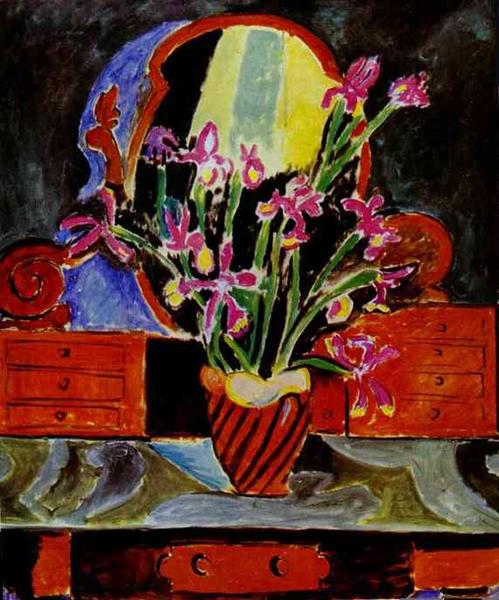Description
Henri Matisse, one of the foundational pillars of modernism in the 20th century, leaves his indelible mark on the work "Vase of Irises, 1912". In this 50x60 cm painting, Matisse displays his unmistakable Fauvist style, characterized by his vibrant color palette and bold use of simplified forms and defined contours.
The composition of the work evidences a mastery in spatial organization and chromatic harmony. The viewer's eye is immediately drawn to the center of the piece, where a semicircular vase of an intense blue color holds a bouquet of irises, painted in shades of blues and violets that create a charming contrast with the orange simplicity of the background. This confrontation of outstanding colors and the central figure highlight the skill Matisse possessed in manipulating color to create depth and dynamism.
A detailed observation reveals the duality of Matisse's feelings: the exuberant energy of color and the serene contemplation of nature. The vase of irises, firmly placed on a table whose perspective is subtly suggested rather than delineated, represents not just an object of beauty, but a focal point that invites the observer to explore the interaction of colors and forms. The stems of the irises are outlined with an almost schematic simplicity, leading us to the essence of the form rather than its detailed representation.
In "Vase of Irises", Matisse deliberately dispenses with the presence of human characters, allowing the still life to speak for itself. This is not an isolated case, but a recurring characteristic in his work, in which he sought to capture the pure essence of objects and life itself through color and form. There are no faces or figures, because what Matisse pursues is the intimate interaction between the painted objects and the viewer.
Matisse's technique in this painting is revealing of his explorations with Fauvism, a movement that seeks to free art from the constraints of realism and the earthy palette of the 19th century. "Vase of Irises" encapsulates Matisse's quest to achieve an intense, almost festive visual harmony, without relinquishing a certain underlying serenity. The vivacity of the orange background, however, does not overwhelm; instead, it acts as a calm sea over which the forms and colors of the vase and the irises float.
It is impossible to observe this work without reflecting on how Matisse managed to distill the visual experience in such a way that the ordinary is transformed into something exceptional and symbolic. This vase of irises is not simply a representation of flowers in a container; it is a celebration of color, a meditation on form, and a tribute to beauty in its most essential and elemental state.
Henri Matisse, through his "Vase of Irises, 1912", emphasizes an artistic statement that still resonates: that the essence of beauty can be captured through the simplest of compositions and the most vibrant of colors. This painting thus becomes not only a visual delight but also a perennial testament to the transformative power of art.

